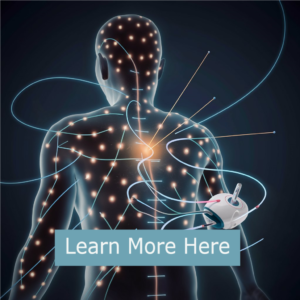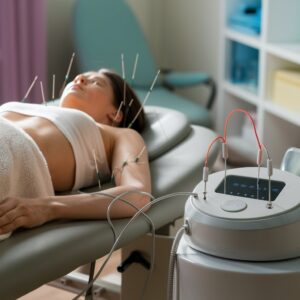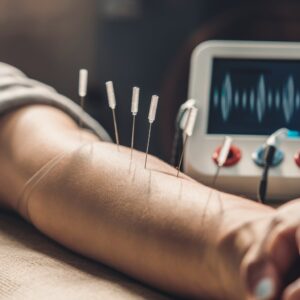Unlocking the Benefits of Electroacupuncture Therapy
Electroacupuncture is a modern adaptation of traditional acupuncture that incorporates electrical stimulation. This technique utilises a mild electric current that is carefully administered through acupuncture needles strategically placed at specific points on the body. Introduced in the 1930s, electroacupuncture has become widely recognised as a valuable adjunctive treatment for various health conditions.
This therapy utilises the placement of thin needles into acupuncture points, which are specific locations on the body traditionally thought to be connected by pathways that carry energy, referred to as “qi.” Applying electrical current to these needles enhances the stimulation of these points, which can potentially amplify the therapeutic benefits of traditional acupuncture. Many practitioners in the field of electroacupuncture often combine this approach with conventional acupuncture methods. Our goal is to optimise the stimulation of acupuncture sites, providing a more robust and reliable method than manual manipulation alone. This approach aims to promote healing and restore balance within the body.
While electroacupuncture originates in traditional Chinese medicine principles, it is currently being studied for its potential benefits in modern medical environments.
Main Points
- Electroacupuncture treatment utilises a gentle electric current to augment the benefits of traditional acupuncture by stimulating the acupuncture needles.
- Electroacupuncture therapy uses a low-frequency electric current to stimulate the acupuncture points, enhancing the treatment’s efficacy.
- Electroacupuncture therapy offers a range of advantages, such as alleviating pain, promoting muscle relaxation, boosting circulation, and enhancing the treatment of specific conditions.
- Electroacupuncture therapy is effective in addressing a wide range of conditions, such as chronic pain, musculoskeletal disorders, neurological disorders, and digestive issues.
- One notable distinction between traditional acupuncture and electroacupuncture therapy is the utilisation of electric currents to amplify the therapeutic outcomes.
- During an electroacupuncture session, patients may experience a gentle tingling or pulsing sensation at the acupuncture points where the electric current is administered.
- When it comes to electroacupuncture therapy, safety must be prioritised. This means finding a skilled and knowledgeable practitioner, ensuring equipment sterilisation is done correctly, and being aware of any contraindications for individuals with certain medical conditions or pacemakers.
 How Does Electroacupuncture Therapy Work?
How Does Electroacupuncture Therapy Work?
Understanding the Process
Applying an electric current can effectively stimulate acupuncture points, amplifying the benefits of traditional acupuncture. This approach can enhance the treatment’s efficacy and accelerate the healing process.
Impacts on the Physical Well-Being
Electroacupuncture Therapy uses electric current to have various effects on the body. Many believe it can enhance the production of endorphins, natural pain-relieving substances created by the body. By utilising this approach, individuals can experience decreased discomfort and cultivate a feeling of contentment.
Extra Perks
Additionally, electric current has the potential to enhance the functioning of the nervous system, boost blood circulation, and facilitate the production of anti-inflammatory substances. These effects could provide relief from pain, decrease inflammation, and support the body’s natural healing process.
The Benefits of Electroacupuncture Therapy
Electroacupuncture therapy offers many benefits for individuals seeking alternative or complementary treatments for various health issues. One of the great benefits of this therapy is its ability to provide relief from pain. Electroacupuncture employs electric currents to relieve pain by stimulating the release of endorphins and modulating the brain’s perception of pain.
Thus, it serves as a beneficial therapeutic option for individuals dealing with chronic pain conditions like arthritis, fibromyalgia, or back pain. Electroacupuncture therapy offers effective pain relief, improves muscular function, and promotes a sense of calm. Using an electric current to stimulate muscular contractions can be beneficial for individuals recovering from injuries or looking to enhance muscle strength and functionality.
In addition, the therapy promotes a sense of calm and well-being by encouraging relaxation and a general feeling of satisfaction. Therefore, it is an excellent therapeutic option for individuals dealing with mental health conditions or looking to alleviate stress.
 Conditions Treated with Electroacupuncture Therapy
Conditions Treated with Electroacupuncture Therapy
Electroacupuncture therapy is a highly effective treatment that addresses various health concerns. It is commonly used with traditional medical care as a complementary treatment. Effective pain management is a widely recognised benefit of this therapy. This product can effectively reduce pain associated with various illnesses, including arthritis, migraines, neuropathy, and musculoskeletal injuries.
Electroacupuncture is beneficial for patients experiencing gastrointestinal issues such as nausea, IBS, and other related conditions. In addition, this therapy has shown promise in addressing neurological conditions such as stroke recovery, Parkinson’s disease, and multiple sclerosis. It can improve motor function, reduce spasticity, and promote overall well-being in individuals affected by these conditions.
Moreover, Electro Acupuncture Therapy has proven to be a valuable tool in supporting patients undergoing cancer treatment. It effectively reduces chemotherapy-induced nausea and vomiting while also providing relief from cancer-related pain.
The Difference Between Traditional Acupuncture and Electroacupuncture Therapy
One notable distinction between traditional acupuncture and electroacupuncture therapy lies in the use of electric current. Acupuncture involves the careful insertion of needles into specific points on the body, which are then gently stimulated by hand. By manipulating the needles skillfully, the objective is to enhance the flow of qi and facilitate healing.
An electric current is carefully applied between pairs of needles to amplify the advantages of traditional acupuncture. This versatility enables a more precise and regulated activation of acupuncture points, enhancing its efficacy as a treatment choice for specific conditions, especially in pain management or muscle function. This flexibility guarantees that the therapy can be customised to meet the unique needs of each individual, creating a sense of thoughtfulness and accommodation.
In addition, individuals who are sensitive to needle manipulation or looking for a stronger stimulation of acupuncture points may find electroacupuncture to be a preferred option.
 What to Expect During an Electroacupuncture Therapy Session
What to Expect During an Electroacupuncture Therapy Session
Getting started with your project: Initial Consultation and Treatment Planning.
During an electroacupuncture therapy session, individuals can anticipate a comparable experience to traditional acupuncture, enhanced by incorporating electric current stimulation. The session usually starts with a consultation with an experienced acupuncturist who will evaluate the person’s health issues and create a personalised treatment plan.
Our Approach to Treatment
The person will then be requested to recline on a treatment table, and the acupuncturist will carefully insert slender needles into specific points on their body, tailored to their particular condition. After the needles are inserted, the acupuncturist will connect pairs to an electroacupuncture device, delivering a gentle electric current between them.
What You Can Anticipate During the Session
During electroacupuncture therapy, it is normal for individuals to experience a mild tingling sensation or muscle twitching at the site of the needles. A skilled practitioner will carefully observe the patient’s progress during the session and make any necessary adjustments to the electric current’s intensity.
Wrap-up of the Session
Once the designated time has passed, usually around 20-30 minutes, the needles will be gently taken out, marking the end of the session.
 Safety and Considerations for Electroacupuncture Therapy
Safety and Considerations for Electroacupuncture Therapy
Electroacupuncture therapy is widely recognised as a safe and effective treatment option when performed by a highly trained and certified acupuncturist. However, certain factors and precautions must be taken before proceeding with this therapy. Individuals must seek treatment from a highly trained practitioner specialising in traditional acupuncture procedures and Electroacupuncture Therapy.
In addition, individuals with certain medical conditions or those who are pregnant should consult their healthcare provider for guidance before undergoing Electroacupuncture Therapy. While this therapy is generally considered safe, it may not be recommended for individuals with pacemakers, epilepsy, or bleeding issues due to contraindications. Furthermore, it is important for individuals to openly discuss any concerns or medical conditions they may have with their acupuncturist to ensure a safe and effective treatment experience.
Electroacupuncture therapy is a unique approach that combines the ancient practice of acupuncture with the use of electric current to enhance its healing effects. This therapy has shown promising results in reducing pain, improving muscle function, and promoting relaxation. Electroacupuncture therapy is a reliable and practical choice for restoring balance and promoting healing in the body.
FAQs
Could you please explain what electroacupuncture therapy entails?
Electroacupuncture therapy involves the application of a mild electric current to acupuncture needles.
Could you please explain how electroacupuncture therapy functions?
Many believe that electroacupuncture therapy can amplify the benefits of traditional acupuncture. By stimulating the acupuncture points and facilitating the flow of energy, or qi, in the body, the electric current is believed to enhance the overall effects.
Which medical conditions can electroacupuncture effectively treat?
Electroacupuncture therapy is a highly effective treatment option for many conditions. It has proven to be particularly beneficial in managing chronic pain, musculoskeletal disorders, neurological disorders, and digestive issues.
Is electroacupuncture therapy considered safe?
Electroacupuncture therapy is widely recognised as a safe treatment when administered by a skilled and licensed practitioner. However, it may not suit everyone, so it’s essential to consult with a healthcare expert before treatment.
What should I anticipate during an electroacupuncture session?
During an electroacupuncture session, a skilled practitioner carefully places acupuncture needles at precise points on the body and connects electrodes to the needles to administer a gentle electric current. The sensation felt during treatment can differ from individual to individual, but it is generally characterised as a gentle tingling or pulsing sensation.
What is the usual number of sessions required for electroacupuncture therapy?
The number of sessions required may vary based on the individual’s unique needs and the specific condition being addressed. Some individuals may find relief after a few sessions, while others may need ongoing treatment for more lasting outcomes.
Brought To You By:
References
- What Is Electroacupuncture https://www.webmd.com/pain-management/what-is-electroacupuncture
- Acupuncture in Chicago: Benefits and Considerations – Clinic Online. https://cliniconline.com/acupuncture-in-chicago-benefits-and-considerations/
The Article: ElectroAcupuncture Therapy: The Key to Realising Potential appeared first on https://mcrtherapies.co.uk
The Article Electroacupuncture: Unlocking Potential appeared first on https://mcrtherapies.com
The Article Electroacupuncture: Unlocking Potential Was Found On https://limitsofstrategy.com


Comments are closed